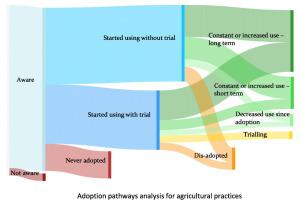Agricultural Systems ( IF 6.1 ) Pub Date : 2021-05-11 , DOI: 10.1016/j.agsy.2021.103173 Oscar Montes de Oca Munguia , David J. Pannell , Rick Llewellyn , Philip Stahlmann-Brown

|
CONTEXT
Scholars have argued that empirical studies of adoption in agriculture should consider adoption as a dynamic process rather than a binary choice, but many empirical studies continue to be based on cross-sectional surveys in which adoption is treated binarily. In general, surveys put more emphasis on investigating adoption drivers (i.e. independent variables) at the expense of defining complete adoption measures (i.e. dependent variables).
OBJECTIVE
In this study, we present, demonstrate and illustrate a method - adoption pathways analysis – as an approach to better represent and analyse the dynamics and diversity of adoption.
METHODS
The approach consists of conducting a survey to define individual decisions at different stages of adoption and producing proportional flow diagrams representing the collective results of adopters moving through these various stages. The method is illustrated for four well-established practices in New Zealand pastoral farming using responses from 138 farmer surveys.
RESULTS AND CONCLUSIONS
Findings show how the current use status for each practice was the result of individual adoption journeys, converging in distinct pathways. For example, the current population of farmers can be broken down into those who have maintained or increased use of a practice over the medium or long term, those who have decreased their use of the practice since first adopting it, those who are still trialling the practice, those who adopted and then dis-adopted the practice, those who are aware of the practice but have never adopted it, and those who are not aware of it. The pathway to adoption may or may not have included trialling of the practice. Anticipating future pathways, we identified that farmers may intend to increase, maintain or decrease their adoption, and that current non-adopters may or may not be interested in future adoption. For different practices, different proportions of the farm population followed different adoption pathways. Observing these differences provides insights into adoption, and adoption barriers, for each practice.
SIGNIFICANCE
Our approach provides a method for adoption research with a highly informative way to unpack the diversity of dynamic adoption pathways for agricultural practices, addressing the current imbalance in survey design that puts more emphasis on potential drivers of adoption at the expense of adoption measures. We discuss the potential uses of adoption pathways analysis to agricultural researchers and extension agents, and its potential to contribute to better explaining past adoption or predicting future adoption.
中文翻译:

收养途径分析:代表农业实践收养的动态和多样性
语境
学者认为,对农业采用的实证研究应将采用视为动态过程,而不是二元选择,但是许多实证研究仍然基于对截面采用二元处理的横断面调查。通常,调查更加注重调查采用动因(即自变量),而以定义完整的采用度量(即因变量)为代价。
客观的
在本研究中,我们介绍,演示和说明一种方法-采用途径分析-作为更好地表示和分析采用动态和多样性的一种方法。
方法
该方法包括进行调查以定义采用过程不同阶段的个人决策,并生成比例流程图,这些流程图表示采用者在各个不同阶段的总体结果。使用来自138位农民的调查问卷的回答,说明了新西兰牧业中四种公认的实践方法。
结果与结论
研究结果表明,每种实践的当前使用状态是如何通过个人采用之旅,汇聚成不同的途径而得出的。例如,当前的农民群体可以细分为在中长期内维持或增加使用该做法的人,自首次采用以来减少使用该做法的人,仍在试用该做法的人。实践,那些采用并随后不采用该实践的人,那些知道该实践但从未采用过的人,以及那些不了解它的人。采用的途径可能包括也可能不包括对该实践的试用。展望未来的发展道路,我们发现农民可能打算增加,维持或减少其采用,而目前的非采用者可能对将来的采用感兴趣或不感兴趣。对于不同的做法,不同比例的农场人口采用不同的收养途径。观察这些差异可洞察每种实践的采用和采用的障碍。
意义
我们的方法为采用研究提供了一种方法,该方法具有高度信息化的方式,可以揭示农业实践中动态采用途径的多样性,解决当前调查设计中的失衡问题,该失衡将更多重点放在潜在的采用驱动因素上,而以采用采取的措施为代价。我们讨论了对农业研究人员和推广人员进行采用途径分析的潜在用途,及其对更好地解释过去采用或预测未来采用的潜力。











































 京公网安备 11010802027423号
京公网安备 11010802027423号